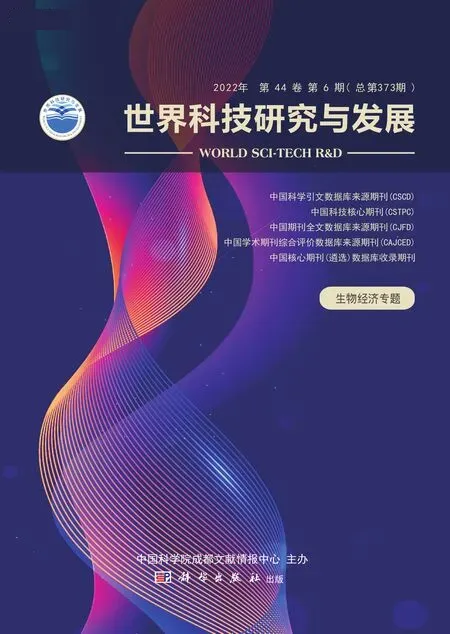A Bioeconomy for the World
2022-02-12ChristianPatermann
Not too many people are still recalling that the the launch of the modern Bioeconomy in 2005 was a joint European-Chinese Undertaking:
In the middle of September 2005 in Europe,in Brussels,in the European Union,Commissioner Potocnik and in parallel in Beijing,his Chinese colleague,Former Minister of Science and Technology Xu Guanhua launched in 2 locally separate conferences“Transforming life sciences into new sustainable,ecoefficient and competitive products”(location Brussels),and“Bioeconomy for Everyone”(location Beijing)the idea of a bioeconomy for the future,with mutual video greetings and delegations being present in both cities[1,2].
This was a very unique event,showing from the very beginning the global,the planetary dimension of this new,but nevertheless oldest economy model in the world.A few months later,within the development of the Chinese Five-Year Plan at that time,my Chinese colleagues forwarded to me an article titled“Biotechnology and Bioeconomy in China”,edited by the China National Center for Biotechnology Development(CNCBD)[3].I found this publication extremely interesting,even fascinating,and I want to quote the first paragraphs of this article just after its introduction under“Achievements”to show also the historical dimension of this development at the beginning of this century to our readers of today:
“a.Pioneer breakthroughs
China is the earliest country in the world using biotechnology.It is said that Chinese people mastered cultivation of crops and rational croprotation in the Stone Age,and in the later part of the Stone Age,Chinese people were able to produce alcohol through fermentation technology.In the Zhou Dynasty(221 BC)technology for making bean curd was developed and has been used till now.In 200 BC,flax dipping with anaerobic bacteria was recorded in“The Book of Songs”,the earliest poems collection of China,In the 10th century AD,vaccine was developed for the prevention of smallpox.
China has a number of“world’s first”in terms of the scale of biotechnological industry.The output of antibiotics,vaccines and vitamins in China is ranked the first in the world;China is ranked the first in production of vinegars,soy sauces,gourmet powder and beers in the world;China is number one in the World in output of organic acids such as citric acid;China is ranked the first in the world in the production and sales of edible fungus……”End of quotation[4,5].
This publication among others is also extremely interesting,when looking at its priorities and key technologies at that date,to be envisaged for the future,ranging from developing agricultural,medical,(modernisation of traditional Chinese medicine and drugs),environmental and industrial Biotechnology,among the latter already“green plastic”and so-called recycling industries(17 years ago!),via promoting“Green Gold”substituting“Black Gold”(renewable energy instead of fossile one)to fostering new bio-industries,green manufacturing and last but not least,guaranteeing Biosecurity in the widest sense.
Against this background of 2006,including also very interesting statements on strategies and approaches,also worthwhile to be read,I permit myself to make a few personal comments.
The very recently published 14th Five-Year Plan for the Development of the Bioeconomy by the National Development and Reform Commission of China is to some extent closing a cycle in a way of continuity fort he Chinese bioeconomy[6].But it also puts strong new elements which are not necessarily to be found in many other of the more than 60 national and regional strategies which have been worked out in the last 17 years.In its center one finds biological ressources,its production,processing use,BUT also its protection.For this purpose the necessary data on biological ressources in China,but also its further development and potentials will be stocktaken,monitored and kept in libraries etc.,a priority which is seldom found in such a dimension in other strategies worldwide.
The new strategy covers also Health,Medicine,preventing and fighting diseases,as well as Biosecurity and Biosafety as important topics beside Food,Nutrion Energy,Industrial Development and Climate Changes.Focussing on these priorities,in particular on Biosecurity and Health,is also quite uniqe compared with the large majority of other strategies worldwide.
Another important difference with many other strategies is the impressive role attributed to the so-called“soft skills”within the development of a bioeconomy:Education,Training,finding the right new talents in research and technology(Talent-Pipeline),communication and new ways of funding.
In addition much attention is paid to the need of developing the right adequate infrastructures for implementing bioeconomies in regions,and here it is remarkable that this does not only remain in abstract descriptions of regions.Relevant regions and urban agglomerations fit for the bioeconomy are explicitly named:Clustering in Beijing,Tianjin and Hebei,the Jangtse-Delta,the greater metropolitan areas of Guandong-Hongkong-Macao,of Shanghai,Jiangsu and Chengdu-Chongqing are explicitly mentioned,a chance and challenge for these regions.The bioeconomy will never fly if it is not properly achnowledged and implemented in local and regional areas!
I am also impressed in seeing that the integration,the embeddment and the close cooperation between life sciences and the biotechnology on one side,and digitilisation,Artificial Intelligence,the wider IT and communication industries on the other side are important elements in the new bioeconomy plan.The latter one will be the strongest challenge of the Bioeconomy of today and tomorrow:How to overcome the disciplinary scientific boundaries in learning,teaching,but also in political and economic decision processes,without jeopardising excellence and quality!
I see therefore the special bioeconomy edition of this Journal,so well known and respected,as an extremely important and helpful step into this direction.
When the Wind of Change is blowing,some people are building walls,others are constructing windmills,an old chinese proverb says:This special edition should be a windmill and a good base to return to joint roots of 2005 of close cooperation!
